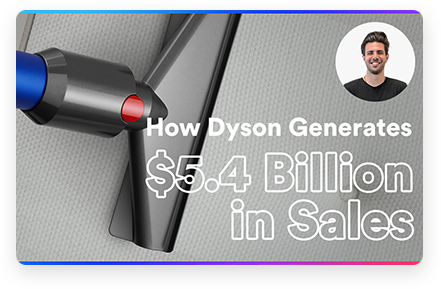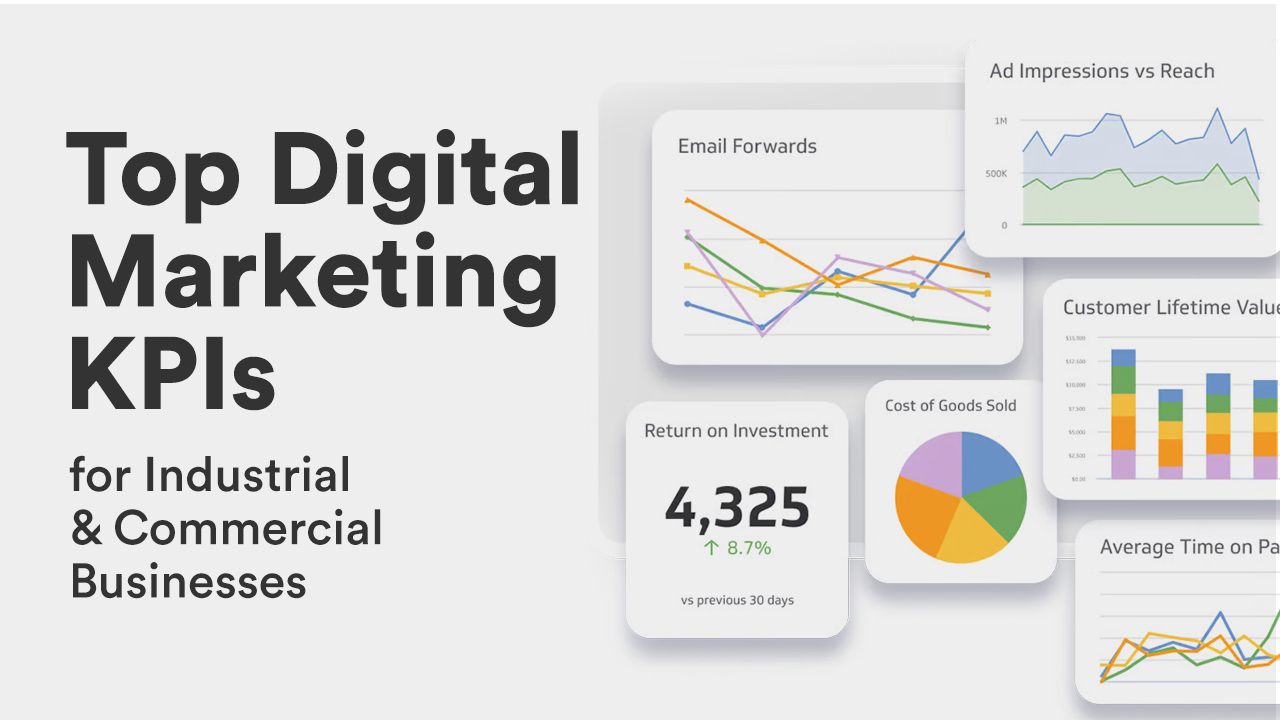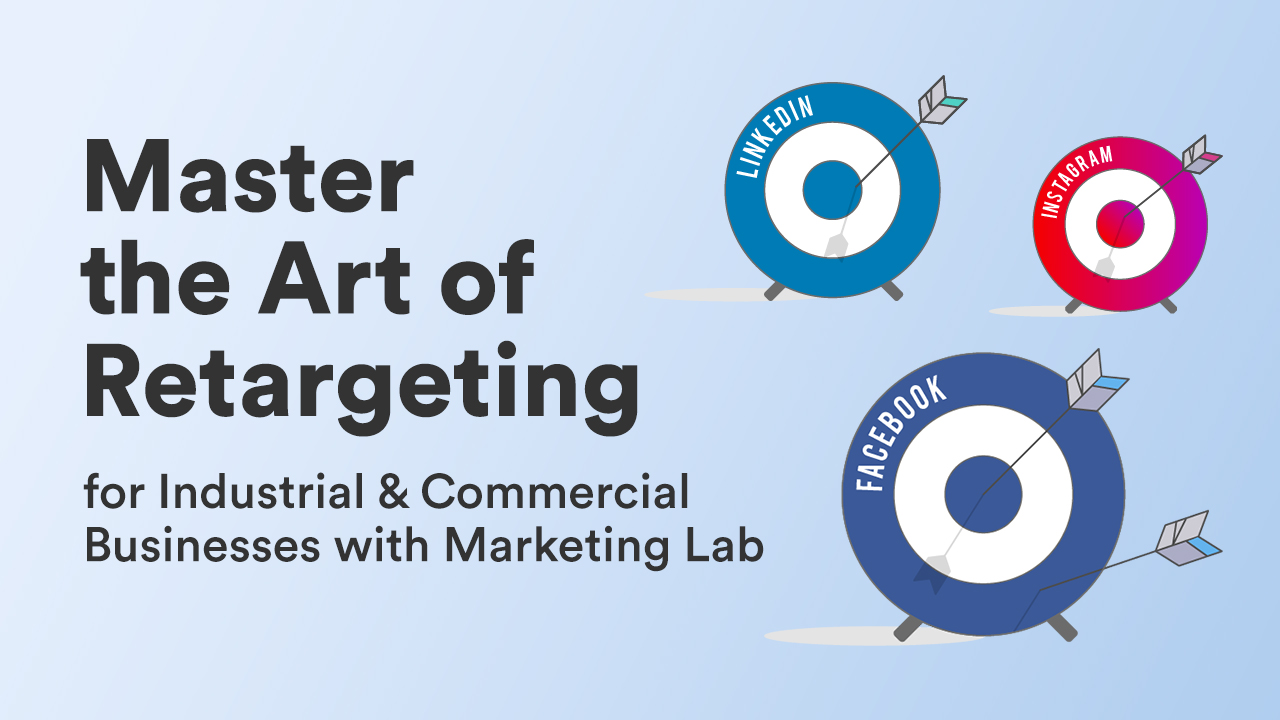
One morning in 1991, James Dyson started to clean his home and became very frustrated with his vacuum cleaner. It was always losing suction, and he was tired of having to empty the bag all the time.
So, he decided to invent a better vacuum cleaner. James spent five long years and 5,127 prototypes trying to create the perfect vacuum cleaner. He tried all sorts of different designs, but nothing seemed to work.
Finally, he had an idea. He remembered seeing a cyclone tower at a factory that used centrifugal force to separate paint particles from the air.
Being a crafty fellow, he wondered if he could use the same principle to create a vacuum cleaner that wouldn’t lose suction.
James built a prototype of his new vacuum cleaner and tested it out. It worked! The cyclone system was able to separate dust and debris from the air, and the vacuum cleaner didn’t lose suction.
Solving such a major problem in the market with an innovative product, James turned to distributing his newly named ‘Dual Cyclone’ vacuum out to the market using a variety of different channels.
And after his first first years in business, Dysons sales grew from $1 million pounds in 1993, to $100 million pounds in 1998. Fast forward to today, and the company’s revenue has soared to nearly $6 billion per year.

Image source: https://www.statista.com/statistics/746505/worldwide-dyson-annual-revenue/
With an award winning design and innovation that keeps pushing the boundaries, Dyson is one of the companies whose marketing strategy has created one of the most recognised and influential brands in the world.
Making the transition to a digital marketing approach in the early 2000’s, its strong online presence is responsible for its staggering growth over the years, and why department stores are being flocked by customers wanting the latest Dyson vacuum.
Now, Dysons growth not only comes from their vacuum cleaners, but other markets which they’ve branched into such as home and beauty appliances, plus music and lifestyle.
But the question remains… How do they keep growing and staying ahead of the game?
In this analysis, I’m going to show you what I believe to be the secrets to Dyson’s success in becoming a powerhouse brand, beating competition, and nailing a digital strategy that ultimately fuels their consistent growth in sales each year.
Note* – I have conducted this analysis using 3rd party tools. I don’t have access to Dysons internal information. This is my opinion, based on my experience, data I’ve discovered about the brand, and information I’ve found online from reputable sources.
Selling Solutions Not Products
One of Dysons biggest strengths and what I believe to be one the keys to their success, is they don’t sell products!
They sell solutions to problems.
From day 1, Dysons product line started off with a vacuum cleaner that solved a big problem in the market, a loss of suction power. Since then Dyson has continued to innovate its products to be problem solving solutions.
Dyson’s First Vacuum

Image source: https://www.lb.dyson.com/en-LB/community/aboutdyson.aspx
Take a look at their latest creation, the Dyson V12. A wet and dry vacuum that keeps your whole house clean, so you no longer need to break out the shaggy mop.
It’s even apparent in their product attachments. The Scratch-free dusting brush.
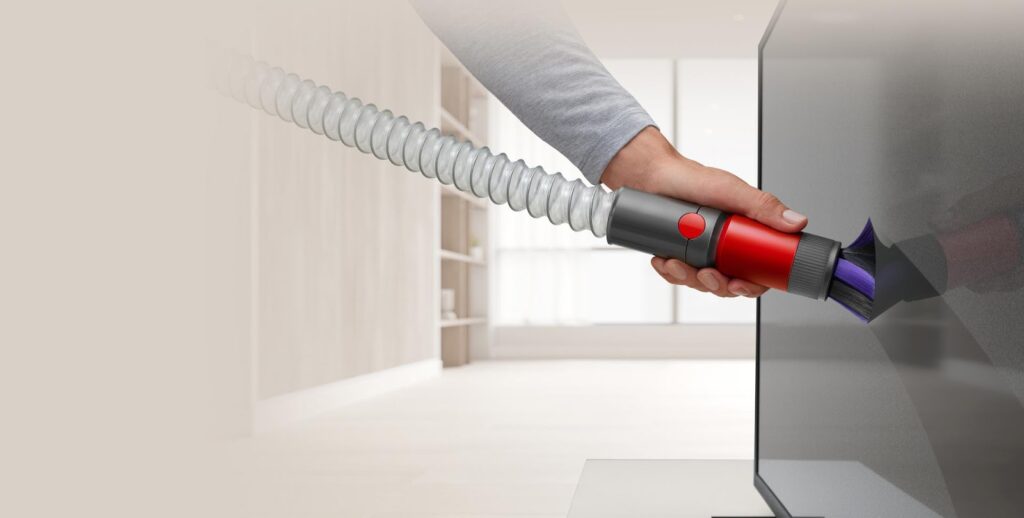
Image Source: https://www.dyson.com.au/scratch-free-dusting-brush-972157-01
This ability to innovate problem solving products is the way Dyson continues to stay ahead of the game, creating products that their market truly desires
Social Media & Influencer Marketing
One of Dysons biggest strengths in social media is the brand’s influencer program.
Using a variety of social media influencers and celebrities, the brand is able to piggyback off their reach, trust and credibility with their audience, to build brand awareness.
Here is the network of influencers they’ve worked with in the past.
– Ryan Reynolds

– Blake Lively

– Chris Hemsworth

– Dwayne Johnson

– Aimee Song

Instagram Account
Dyson has their own instagram account of course. With over 815,000 followers, and their most viewed video reaching 1.4 million likes and 10,000 comments, Dysons visibility online is fantastic.
Averaging a post every 3 days, Dysons social media has nailed their short term video content, which is highly engaging whilst showcasing their range of products.
Also accompanied by great hashtags and captions that explain the benefits of the product, Dysons instagram account is one we can all learn from.
Youtube
Dysons Youtube channel has 430K subscribers. Pretty impressive for a company that started off making vacuums.
What I love about their channel is that they have a strong focus on three types of videos they produce.
1. The innovation and technology behind their products

Video source: https://www.youtube.com/watch?v=2tkOvs4TL3A
2. Lifestyle videos of ideal customers using their products

Video source: https://www.youtube.com/watch?v=YlLxiLqH4-Y
3. How to videos demonstrating key features of their products
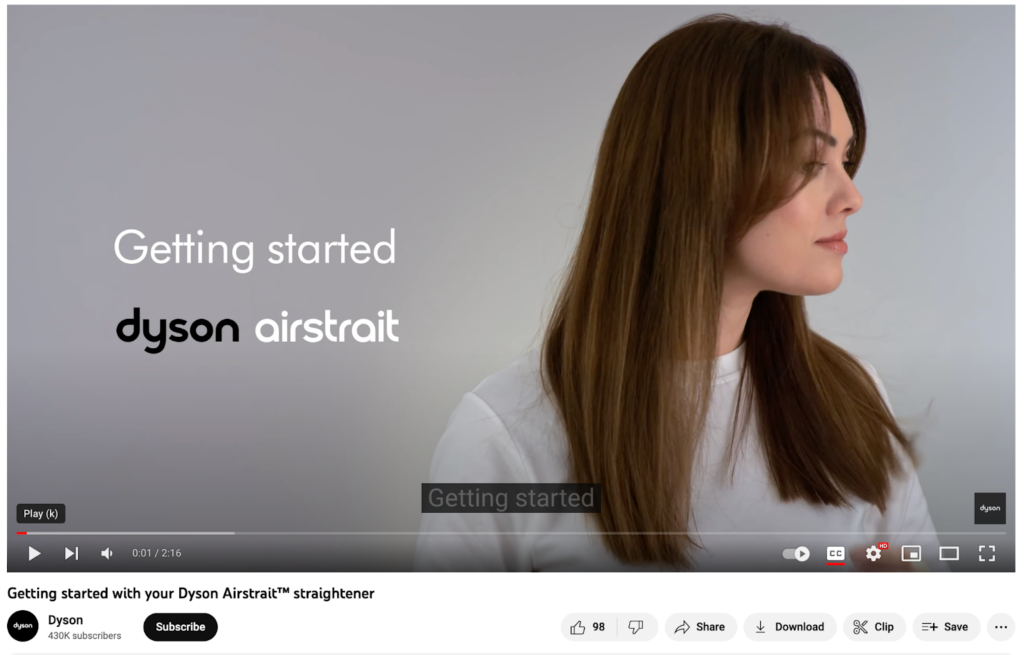
Video Source: https://www.youtube.com/watch?v=0-Lm9oWzENY
This combination of video creation is great, because it not only continues to voice what the company is strong at (innovation), it paints the picture of who is using their products, and how to use their products.
YouTube as a platform, is predominately used to generate brand awareness and interest around products. And Dyson gets that.
Overall, these videos blend very well together and really appeal to their target market. According to Social Blade, Dysons YouTube channel gets an average of 2.5 million views per month.
And that’s without even mentioning the brand recognition and awareness they get from other people on Youtube reviewing their products. To put this into context, the most popular review video has over 2.1 million views.

As you can see Dysons social media channels are doing a wonderful job at getting eyeballs onto their products and brand. But their social accounts only bring in a combined 16.21% of their overall traffic.
So where is most of their traffic coming from?
SEO
As marketers, we often battle with businesses in trying to explain the importance of SEO. It’s a long-term game and results aren’t generated overnight, but if you do have a good SEO strategy in place, you’ll reap the rewards of generating large amounts of high-quality traffic to your business.

Image source: https://neilpatel.com/ubersuggest/
Dyson receives over 873,487 visitors to their site each month, and their website ranks #30 in the Computers Electronics and Technology category on Google globally.
That’s a mind boggling 29,116 visitors per day, and it all comes from Search.
And how much does that traffic cost them? Nothing, it’s free.
Now there are probably hundreds of things that Dyson is doing right in the SEO game which is contributing to their success. But for this analysis, I’m going to share the top 4 things which I think have been the biggest levers to generating such staggering results in SEO.
1. Keyword Ranking

Image source: https://neilpatel.com/ubersuggest/
The list above shows the top 18 keywords Dyson ranks in the number one position for, and they’re all product related.
In total, these top keywords total a monthly search volume of 713,000.
Now let’s do the math. According to Google the top organic search listing gets around 40% of the total traffic.
That’s 285,280 visitors. If 1% of those visitors converted into a sale, that’s 2852 sales, each month, from completely free traffic.
Very powerful stuff.
But how does Dyson rank so well for these key terms?
2. Blog Articles & Back Links
Blog Articles

Dysons highly engaging blog site, is definitely contributing to their success in ranking for the key terms you saw above.
According to SimilarWeb, Dysons blog receives 1.5 million monthly visitors.
They have over 1,000 blog articles on the website, covering topics related to vacuum cleaners, other products, company news, and recognitions.
Apart from their being a large volume of articles, let’s take a look at why their blog site does so well in ranking online:
1. They produce high-quality content. Their blogs are well-written, dense with helpful content, and highly engaging.
2. Relevant keywords. All blogs are optimized for relevant keywords that people are likely to search for surrounding their brand, products, and generic high volume terms.
3. Regularly Updated. On average, Dyson puts out a new blog every 3-5 days.
4. Social Media Promotion. Dyson fuels its social campaigns with reference to its blog posts to generate wider reach and drive more traffic to blog posts.
Backlinks
Backlinks is a full list of websites that have a link pointing to Dyson.com.au somewhere on their site.
Dyson has over 60,000 websites pointing back to them. As you can see from the graph below, they’ve had steady growth over time.

Now, it’s not all about the number of backlinks you have, it’s got more to do with the quality of the websites that are pointing back to your site.
If those websites have a high authority (rank given by Google), and they’re talking about your business in a good way, then you will be ranked higher, because the quality of your backlinks is good.

Here are the top domain authority sites that are backlinking to Dyson.
As you can see the list is made up of sites such as Forbes, Daily Mail, The Guardian, Yahoo, Reddit, Wikipedia and more.
3. Referral Sites
According to Ahrefs, the top 10 websites that refer to Dyson’s website send the following amount of organic traffic
– Amazon.com 10.8%
– Google 9.2%
– YouTube 8.4%
– The Home Depot 7.6%
– Best Buy 6.8%
– Walmart 6%
– Target 5.2%
– Bed Bath And Beyond 3.6%
– Costco 2.8%
That’s a large number of users visiting the Dyson website after visiting another website.
These referral websites also indicate to Google that Dyson is an authority site, because these authority sites are pointing to it.
So it’s a win, win for Dyson here.
4. Page Speed
An important factor in rankings that is often overlooked by businesses is page speed.
How does page speed affect ranking?
If your website is slow, takes too long to load, users are more likely to bounce. Google will see that your website has a high bounce rate, which is a negative signal, and will drop your rankings.
I used GT Metrix to run a speed and performance test for Dysons website.
Unfortunately for Dyson, they’re letting themselves down in this aspect.
According to the results, their website scores an overall ranking of 21% in terms of performance. I’m very surprised at this result, considering the sheer size of the brand, and the amount of traffic their website sees every day.

According to Google, the recommended time for a fast loading website needs to be within 3 seconds.
Dysons website loads in a total of 8 seconds. But what could be hurting them even more than loading time, is how long it takes for their site to become interactive.
According to this test, it takes 5.2 seconds before the site is interactive, meaning a visitor is unable to press any buttons, click on links or scroll down the page until that time is up.
This would seriously frustrate users and cause them to bounce. If I was Dyson, I’d turn my attention to fixing this right away.
Overall, the company’s SEO channel is their strongest channel across the board, bringing in 61.4% of the total traffic to their website.
This means 2 out 3 visitors to Dyson come completely free, truly showing you the power of what a well-built, content heavy, well ranking website can do for your business.
As mentioned earlier, SEO is a long form game. Dyson has been at it for quite some time, and yes they’re generating great results from it, but this hasn’t stopped Dyson from leveraging other important marketing channels such as Paid Media.
Paid Media
Together with a strong SEO game, Dysons paid marketing campaign allows them to occupy more real estate in the Google search results for keywords that they aren’t ranking for organically, put their ads in front of buyers quicker and smarter, be seen across a wider variety of channels and partnered sites, and gain data faster so they can make better informed marketing decisions.

As we can see, Dysons top ads are being driven to individual product pages, which is a major benefit of running Google ads to an E-commerce store.
Buyers can simply go from ad to product page without distraction, which is highly beneficial for boosting conversions.
But Dysons true advantage comes from being able to sell directly to consumers and through retailers. This advantage gives them the ability to focus most of their paid advertising budget on long-tail product specific and brand specific terms, whilst their retailers go after short-tail, high-volume keywords which are much more competitive, such as Vacuum, Vacuum Cleaner, Stick Vacuum etc.
However, Dyson does invest some of its budget into running a Google Shopping campaign. Smart move on their behalf, as Google shopping ads are visual, and they get top priority in the search engine.
To see how well Dyson’s paid campaign is working for them, let’s run a quick test.
I’ve typed the keyword ‘Vacuum Cleaner’ into Google. Now take a look at how many spots Dyson fills with ads, and also the number of retailers pushing Dyson products.

Pretty strong presence on the first page of Google for a short-tail, highly competitive keyword like ‘Vacuum Cleaner’.
Dyson does a great job at bringing traffic to their site through paid ads, let’s see how well they retain website visitors.
Remarketing
I’ve spent countless hours on the Dyson website putting this case study together, adding multiple products to cart, going through the checkout process, and I’m yet to be hit with a remarketing ad.
Personally, I’m quite surprised considering how much time I’ve spent on their website, you’d think I’d be a good candidate for a remarketing ad.
Who knows, in the coming days I might be served a few.
Just like Google Ads and SEO, remarketing is a big area of opportunity for Dyson and most businesses.
Considering most of their products are worth over $1000, a remarketing campaign would work well for Dyson, and here’s why:
Relying on people to purchase a Dyson product during the first time they visit their website is a far stretch, especially when the price point of their product range is high.
Naturally, most visitors will shy away from making a purchasing decision, and take their time to think about it.
During this period of time, a remarketing campaign would be a great way to serve ads to those people who are ‘On the Fence’, reminding them of how great the product is, and over time building trust with them.
If done right, remarketing can be very cheap and extremely profitable
Without a remarketing campaign, you do leave a lot up to chance. And considering the cost of buying traffic these days, I would’ve thought Dyson would be doing everything to improve their ROI and ROAS (return on ad spend).
This is an area I would invest in if I was on the Dyson team.
Even though I wasn’t targeted here, let’s move to a channel where I was.
Email Marketing
A channel that I was targeted on was email.
After signing up for a few weeks, I was able to gain a good understanding of Dysons email-marketing strategy.
Here’s what I learnt.
Dyson on average sends out 2-3 emails per week, a fairly strong email strategy if you ask me.
They obviously know that email provides a higher return on investment than other channels, so they invest more time and money into this strategy.
Below are snapshots of the emails I received.

Subject: Save $100 on the Dyson V15 Detect Absolute

Subject: Manage pet allergies with Dyson technology
As you can see they’re designed to perfection. Their team puts a great deal of effort into the visual aspect of their emails, helping Dyson stand out in an inbox full of others.
In the first email, we can see that promotions and discounts are used to incentivise shoppers to go over to their website and buy their products.
In the second email we see a completely different approach. This email is purely focused on educating. It’s targeted to a particular market (Pet Owners), with the intention of bringing awareness to a problem and how the Dyson vacuum can help solve that problem.
What this shows me is that Dyson really understands their email list and segmentation.
They cater to all types of audiences using different types of content, which helps them stay relevant and keeps engagement levels high.
One thing I haven’t seen from Dyson is abandoned cart emails.
It’s a great way to get shoppers back to your website, and finish their checkout process.
With the amount of visitors that start the checkout process and leave, it would be a smart way to capitalize on those who drop off right before purchase.
Conclusion
Now that we’ve gone over the 5 digital strategies that I personally believe have helped Dyson reach $5.4 billion in sales, here’s what we can learn and adopt into our business.
From the strategies that have been analyzed above, it’s safe to assume that Dyson understands the importance of leveraging multiple marketing channels and strategies to scale and grow their business. They’ve created a seamless and integrated customer experience across various touchpoints, helping them cement their position as the leader in the marketplace.
By adopting an omni-channel approach, Dyson was able to build a brand that is recognised globally. They understand the power of what each marketing channel can bring them, and that’s how I truly believe they’ve always been ahead of the game.
But as you saw, even a global brand like Dyson had areas which can be improved, and that’s the true beauty of this game. It continues to evolve, and there’s always something you could be implementing or testing within your business.
It’s now evident more than ever that if businesses do want to win in today’s digital landscape, an omni-channel approach is the way to go.
Written By

Nikolas Jamieson – Digital Marketing Strategist at MarketingLab. An agency that specialises in selling high ticket, complex and technical products over the web.




